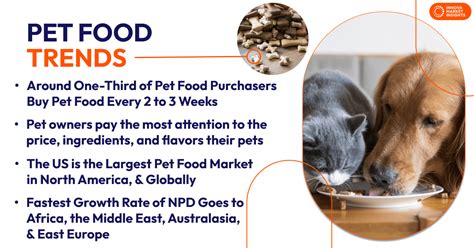Introduction
The global market for natural pet food is experiencing an unprecedented surge, driven by increasing consumer awareness of the importance of nutrition for their beloved companions. According to a recent study by Zion Market Research, the market is projected to reach $21.82 billion by 2025, growing at a CAGR of 7.5%. This growth is attributed to several key trends that are reshaping the industry and transforming the way we feed our pets.

Trend 1: Grain-Free and Low-Carbohydrate Diets
Traditionally, grains like corn, wheat, and rice have been the primary ingredients in pet food. However, many pets are intolerant to grains, and recent research has suggested that high-carbohydrate diets can contribute to obesity, diabetes, and other health issues. As a result, grain-free and low-carbohydrate diets are gaining popularity. These diets often include high-quality proteins, such as chicken, fish, or lamb, along with fruits, vegetables, and healthy fats.
Trend 2: Functional Food for Pets
Functional food is designed to provide specific health benefits beyond basic nutrition. In the pet food industry, functional ingredients like probiotics, antioxidants, and omega-3 fatty acids are being incorporated into a wide range of products. Probiotics promote gut health and overall well-being, while antioxidants support the immune system and reduce inflammation. Omega-3 fatty acids are essential for brain function, skin health, and reducing joint pain.
Trend 3: The Rise of Human-Grade Pet Food
Consumers are increasingly demanding the same standards of quality for their pets’ food as they do for their own. Human-grade pet food is made with ingredients that are fit for human consumption, and it is often produced in facilities that are inspected by the USDA or other regulatory agencies. This trend is driven by the growing understanding that pets are part of the family and deserve the best possible nutrition.
Trend 4: Personalized Pet Food
Just as personalized nutrition is gaining traction in human health, it is also becoming a major trend in pet food. Personalized pet food is tailored to the unique needs of each individual pet, taking into account factors such as age, breed, activity level, and health conditions. This approach allows pet owners to provide their furry friends with the optimal diet for their specific requirements.
Trend 5: The Importance of Sustainability
Consumers are becoming increasingly aware of the environmental impact of their choices, and this includes the products they buy for their pets. Sustainable pet food is produced from ethically sourced ingredients and uses environmentally friendly packaging. Some pet food companies are also working to reduce their carbon footprint and support sustainable farming practices.
Trend 6: The Premiumization of Pet Food
Pet owners are willing to spend more on their pets, and this is translating into a growing demand for premium pet food. Premium pet food products are typically made with higher-quality ingredients, are more palatable, and offer additional health benefits. This trend is driving innovation in the pet food industry, as manufacturers compete to offer the best possible products for discerning consumers.
The Future of Natural Pet Food
The natural pet food industry is poised for continued growth in the years to come. Consumers are increasingly demanding healthy, high-quality products for their pets, and manufacturers are responding with innovative new products and technologies. The trends discussed in this article are likely to continue to shape the industry in 2025 and beyond.
Conclusion
The natural pet food industry is undergoing a major transformation, driven by consumer demand for healthier, more sustainable, and more personalized products. The trends discussed in this article are just a few of the many forces that are shaping the industry and revolutionizing the way we feed our pets. By understanding these trends, pet food manufacturers can develop innovative new products that meet the evolving needs of their customers.





















